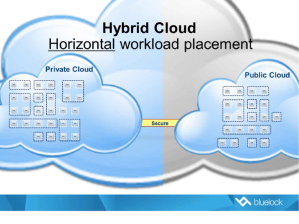Hybrid clouds comes in flavor of both private and public cloud
infrastructures so as to achieve high reliability and a maximum of cost
reduction through outsourcing and simultaneously maintaining desired
degree of control over it. For example critical information can be
employed over local private clouds. Within this model, a public cloud is
leveraged to extend or supplement an internal cloud. For example, a
company may employ an internal cloud to share physical and virtual
resources over a network, but extend these capabilities when needed such
as at peak processing times.
Pros and Cons
A mixed cloud infrastructure model supports high capacity time periods and mitigates security risks on mission critical applications. It enables you to leverage the advantages of public cloud for more portable and appropriate applications, while maintaining control over legacy and vital systems with greater compliance, performance, and security requirements. The hybrid model also provides an optimal approach for architecture since organizations can combine local infrastructure with infrastructure that is scalable and provisioned on demand. A mixed model offers cost saving and provisions unlimited flexibility. It provides the solution for the problem raised due to elasticity. Because of these considerable advantages, a hybrid cloud model is likely to be the most widely adopted
Cons in this model include the complexity of managing and monitoring the infrastructure in the cloud from a common portal or service desk. Automation at all the portions of the hybrid cloud is complex. This requires considerable engineering on the part of the IT organization or the acquisition of third-party vendor services to provide the necessary “glue” to oversee the enterprise environment wealth of information on how to enhance their business value while reducing costs and freeing resources for more strategic initiatives.
Pros and Cons
A mixed cloud infrastructure model supports high capacity time periods and mitigates security risks on mission critical applications. It enables you to leverage the advantages of public cloud for more portable and appropriate applications, while maintaining control over legacy and vital systems with greater compliance, performance, and security requirements. The hybrid model also provides an optimal approach for architecture since organizations can combine local infrastructure with infrastructure that is scalable and provisioned on demand. A mixed model offers cost saving and provisions unlimited flexibility. It provides the solution for the problem raised due to elasticity. Because of these considerable advantages, a hybrid cloud model is likely to be the most widely adopted
Cons in this model include the complexity of managing and monitoring the infrastructure in the cloud from a common portal or service desk. Automation at all the portions of the hybrid cloud is complex. This requires considerable engineering on the part of the IT organization or the acquisition of third-party vendor services to provide the necessary “glue” to oversee the enterprise environment wealth of information on how to enhance their business value while reducing costs and freeing resources for more strategic initiatives.

No comments:
Post a Comment